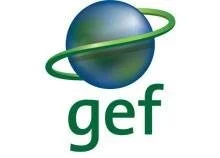Schools told to do more ‘greening’
Quality assurance officer and project manager for the Greening BIMAP project, Chevron Nesfield, explaining to SGP National Coordinator, Dr David Bynoe how the plumbing changes helped them reduce their water bill.
Not enough public schools have been capitalising on opportunities to green their compounds and significantly slash their energy costs.
That was the observation of the National Coordinator of the United Nations Development Programme’s (UNDP) Global Environment Facility Small Grants Programme (SGP), Dr David Bynoe, who suggested that there was a need to incentivise more primary and secondary schools to find ways to secure funding for renewable energy projects.
He made those comments yesterday while touring Barbados Institute of Management and Productivity (BIMAP), at Wildey, St Michael, to assess how the educational facility used the SGP funding to install photovoltaic systems, improved their plumbing, converted their lighting to LED bulbs and educated students about the importance of greening.
BIMAP’s head of business development and IT Services Marqita Phillips(left) and Information Technology (IT) and Data Protection Officer at BIMAP Sharif Chandler (left) highlighting the 40 kW DC PV system that helped BIMAP to achieve a 90 per cent reduction in their electricity bill during the tour to Programme Assistant, Karen Harper.
Constant demand
“We have seen a constant demand for projects like these. However we have several schools across Barbados, both secondary and primary, which are owned by the Government and sometimes at the primary level the Government foots the bill for electricity.
“But you find that the leadership is not that keen to go towards renewable energy, because the bill is going to be paid anyway. We need to incentivise primary schools to green their schools and secondary schools they have a bit more incentive to do so than the primary schools, but we are still not seeing the uptake that we would like,” Bynoe said.
He reminded that the Government has committed to transition the country to become a 100 per cent renewable carbon-neutral island by 2030.
While using the Substance Abuse Foundation’s greening initiative as an example, he reminded schools that they were there to assist.
He said the Substance Abuse Foundation invested more than $500 000 in renewable energy and they have made significant revenue annually and therefore are expanding from just using the rooftop to using about an acre or two in renewable energy.
“Therefore there are opportunities there to create a sustainable financing model in educational institutions within the social sector. We are offering grant financing to assist with this and therefore we would expect that more schools would request this type of financing, but we are not necessarily seeing the demand in that sector,” he added.
The SGP contributed US$50 000, while there was cash co-financing of US$38 199.22 and inkind co-financing valued at US$1.5m.
The project, which began in 2021 and is expected to be completed in 2023, focused on several areas aimed at climate change mitigation.
Achievements
Some of the achievements included BIMAP’s blended faceto-face and online teaching methods, which have helped to reduce their paper usage, the posting of signs to encourage students to save electricity and the training of students to install PV systems.
During the tour which also included Government representatives of the National Steering Committee, quality assurance officer at BIMAP, Chevron Nesfield told the UN officials about the reduction in their electricity and water costs after the 40kW DC Pv system was installed and following the replacement of 50 per cent of their plumbing fixtures.
“The institute has saved approximately about 90 per cent on its electricity bill and we’ve also seen a 30 per cent reduction in our water bill. “We’ve reduced our paper consumption by at least 50 per cent, as persons are conscious about printing and copying. They’ve reduced that and utilise email and the phone much more than before,” Nesfield said.
Original article written by Tre Greaves, Nation Newspaper dated March 24, 2023.




